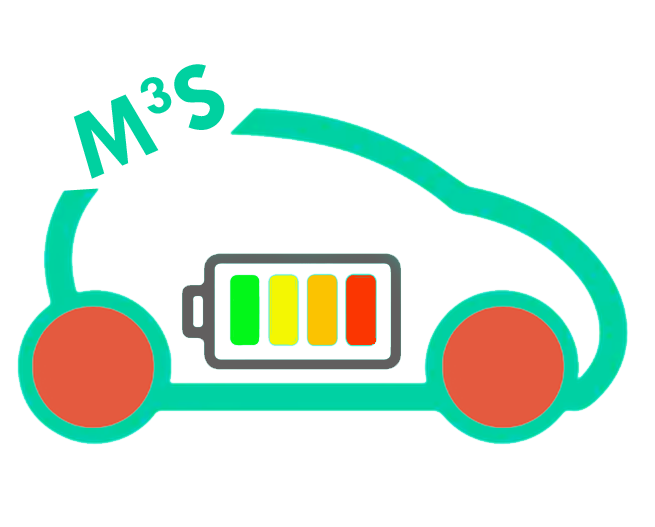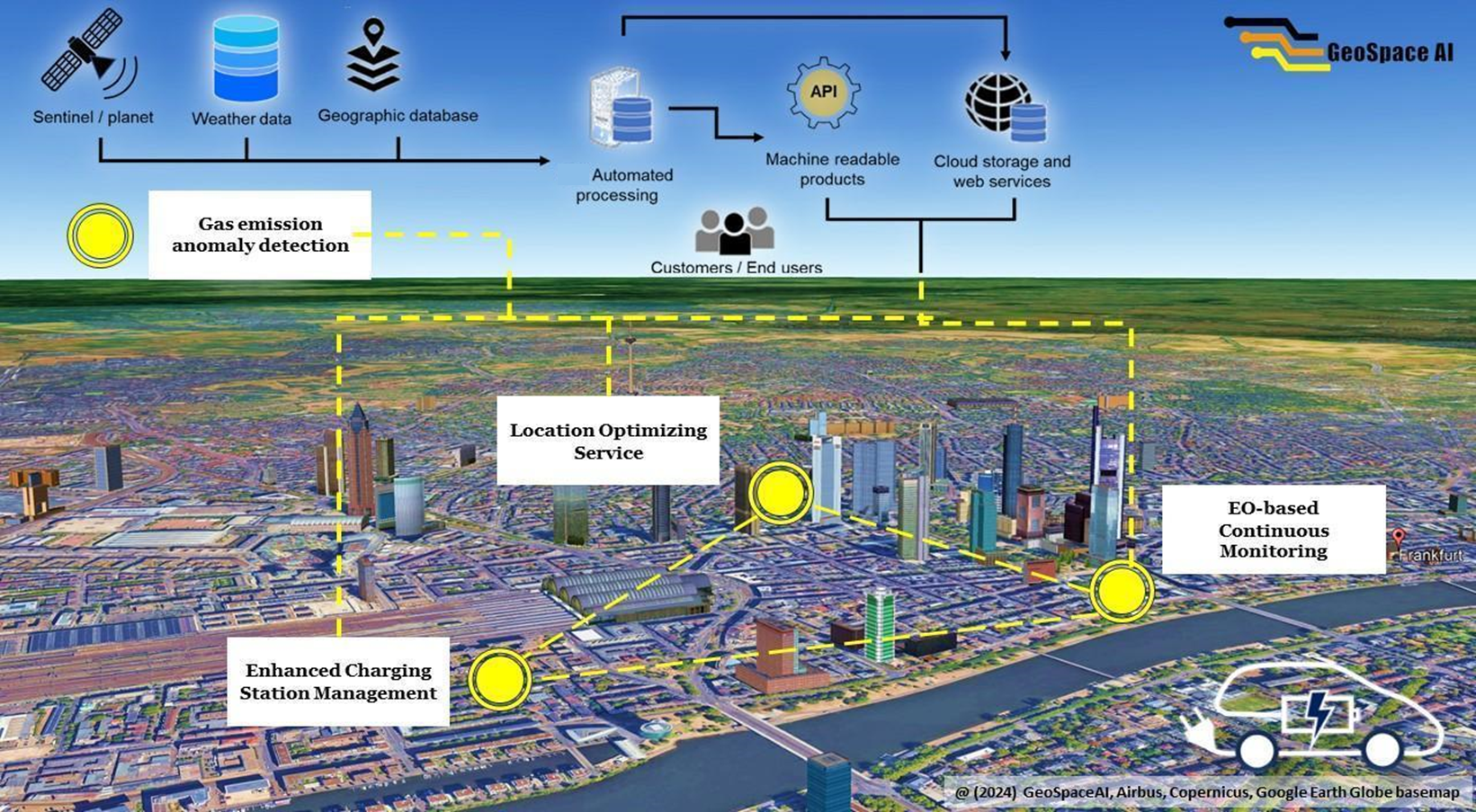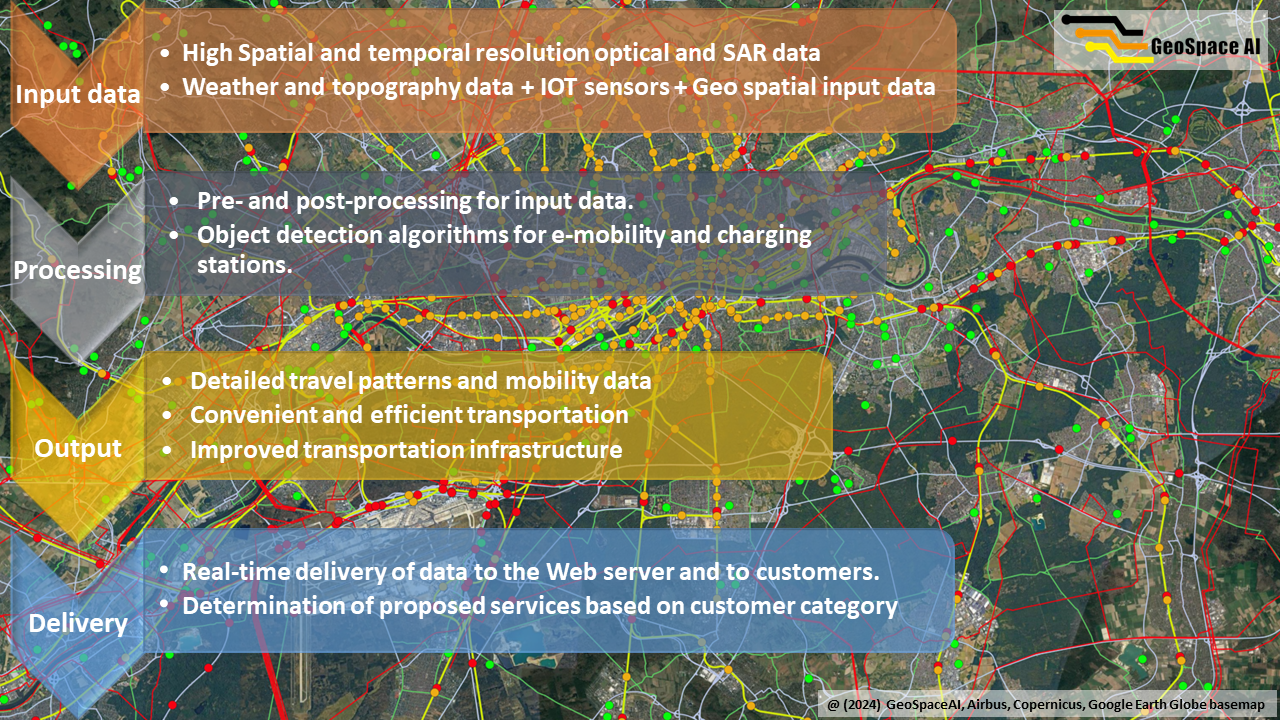
Objectives of the service

GeoSpaceAI empowers key stakeholders in the micro-mobility ecosystem, including micro-mobility operators, urban transport authorities, and urban planners. By leveraging insights derived from Earth Observation (EO) satellites, AI and geospatial technologies, these stakeholders can optimize micro-mobility deployments, manage fleets more effectively, and contribute to the creation of a sustainable and efficient urban transportation system.
-
Engaged stakeholders: The expanded potential customer base will open communication with key stakeholders (e-mobility operators, city authorities and utilities). This feedback will guide service development and market focus.
-
Market analysis: Conducted research in Germany and Europe to understand diverse regional needs and ensure solutions are effectively targeted.
-
Refined services: Based on user and customer analysis, we have updated our service offerings and are exploring the integration of valuable data such as charging point information.
-
Data Analysis: Complete initial data analysis using existing satellite imagery.
-
Data Processing: Develop a core data processing engine to handle Daily and historical data streams.
-
Partnerships: Establish partnerships with EO data providers to expand coverage and improve data quality.
Users and their needs
Customers require efficient and sustainable solutions to optimize routes, identify high-demand areas, and proactively address fleet vehicle issues. EO satellites and geospatial technologies provide valuable data and insights to fulfill these needs.
Key Users and Needs:
-
Micro-Mobility Operators: Optimize deployments, reduce clutter, improve accessibility, enhance fleet tracking, predictive maintenance, and improved response times.
-
Urban Transport Authorities and City Planners: Promote green transportation options, reduce traffic congestion, contribute to sustainable urban systems.
Service/ system concept
Capabilities:
-
Daily Data Dashboards: Visualize key metrics such as vehicle location, battery levels, and usage patterns.
-
Demand Forecasting: Identify high and low demand areas to optimize vehicle deployment.
-
Route Optimization: Suggest efficient routes to rebalance fleets and reduce travel time.
-
Maintenance Alerts: Receive notifications of possible vehicle issues based on sensor data.
How It Works:
-
Data Collection: Satellite and ground IoT sensors collect data on traffic, weather, and EV locations.
-
Data Processing: Advanced algorithms and machine learning analyze the data.
-
User Interface: Insights and recommendations are delivered via a user-friendly web platform and or mobile app.
System Architecture:

User Benefits:
-
Improved decision making: Data-driven insights enable informed decisions on fleet management and deployment strategies.
-
Increased efficiency: Optimized routes and proactive maintenance reduce operating costs and downtime.
-
Sustainable cities: Encouraging micro-mobility helps reduce congestion and improve air quality.
Space Added Value
Space Assets: Earth observation (EO) satellites provide:
-
Wide-area coverage: Monitor entire cities at once, unlike ground sensors with limited reach.
-
Daily and historical data: Track and analyse changes in demand and usage patterns over time.
-
Weather insights: Optimize operations based on weather conditions, improving safety and efficiency.
Added Value:
-
Superior Data Scope: M3S provides a more comprehensive view of micro-mobility activity compared to ground sensor-only solutions.
-
Actionable Insights: EO data combined with other sources offers deeper insights for strategic decision making.
-
Future-Proof Approach: Leverages the evolving capabilities of EO satellites and AI, ensuring continuous improvement and adaptation.
Current Status
Current Work:
-
Integrate Daily data feeds from selected EO satellites and ground sensors.
-
Refine machine learning algorithms for demand forecasting and route optimization.
-
Design the user interface for the web platform and mobile application.
Next Steps:
-
Customer Needs Analysis: Analyze collected e-mobility data to identify specific needs and preferences.
-
Customer Engagement: Use data insights to refine M3S and gain deeper understanding through targeted interactions (meetings, interviews, surveys).
-
Continuous Improvement: Evaluate and improve based on user feedback and real-world data.
-
Pilot Testing: Test the M3S platform with a micro-mobility operator in a major city.


